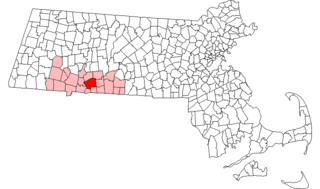
The B and B Chemical Company is an historic office and industrial building at 784 Memorial Drive in Cambridge, Massachusetts. Built in 1937 for an adhesive manufacturer to a design by Coolidge, Shepley, Bulfinch & Abbott, it is a prominent local example of Streamline Moderne architecture. It served for many years as the headquarters of the Polaroid Corporation. The building was added to the National Register of Historic Places in 1982. It is now owned by The Bulfinch Companies of Needham, Massachusetts.

The Ace Art Company is a historic commercial and industrial building at 24 Gould Street in Reading, Massachusetts. Built in 1924, the single-story brick building is the only Art Deco building in Reading. It was listed on the National Register of Historic Places in 1985.
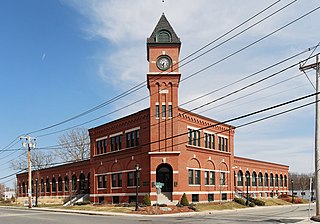
The H.F. Barrows Manufacturing Company Building, now the North Attleborough Police Station, is a historic industrial building at 102 South Washington Street in North Attleborough, Massachusetts. The elegant brick building was built in 1905-06, and was home for many years to one of the town's most successful jewelry businesses. It was listed on the National Register of Historic Places in 2001. Today the building serves as the headquarters for the North Attleborough Police Department.

The F. A. Whitney Carriage Company Complex Historic District encompasses a major 19th-century industrial complex off 124 Water Street in Leominster, Massachusetts. The complex is one of the best-preserved in the city, and was developed by of its most successful businesses of the late 19th and early 20th centuries. The F. A. Whitney Company, founded in 1858, manufactured baby carriages and related products, and operated here from 1862 to 1952, and was one of the city's major employers. The oldest surviving buildings of its manufacturing complex date to 1872. The district was listed on the National Register of Historic Places in 1988. Most of the complex has been converted into residential use.

The Baystate Corset Block is a historic commercial block at 395-405 Dwight St. and 99 Taylor Street in Springfield, Massachusetts. Built in 1874 and twice enlarged, it was from 1888 to 1920 home of the Baystate Corset Company, one of the nation's largest manufacturers of corsets. The building was listed on the National Register of Historic Places in 1983.
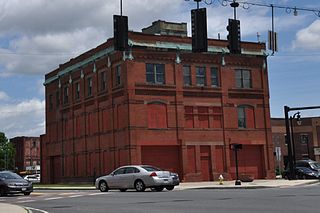
Winchester Square Historic District is a historic district encompassing a cluster of brick buildings at and near the intersection of State Street and Wilbraham Road on the east side of Springfield, Massachusetts. The buildings, most of which were built for industrial purposes, are clustered on five parcels, and were built between 1875 and 1913. It includes the Armory railroad station (1875), the Winchester Square fire station, the Knox Automobile Company buildings (1891-1910), and the Indian Motorcycle Company plant, part of which later became the Springfield Industrial Institute complex. The district was listed on the National Register of Historic Places in 1979.
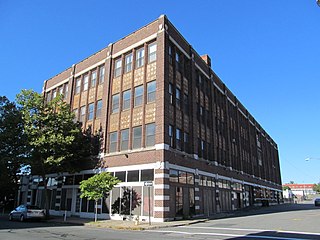
The Willys–Overland Block is a historic commercial and industrial block at 151-157 Chestnut and 10-20 Winter Streets in downtown Springfield, Massachusetts. Built in 1916, it is a surviving reminder of Springfield early history in the manufacture and sale of automobile, housing the sales showroom and service center for the Willys–Overland Company. It was listed on the National Register of Historic Places on February 24, 1983.
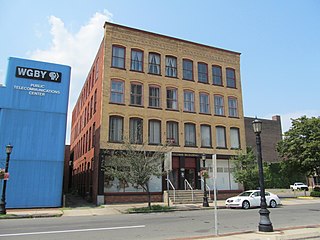
The Whitcomb Warehouse is a historic warehouse at 32-34 Hampden Street in Springfield, Massachusetts. Built in 1896, it is one of the most intact late 19th century industrial buildings in Springfield. It was listed on the National Register of Historic Places in 1983.

The Wason-Springfield Steam Power Blocks are a collection of three historic commercial blocks at 27-43 Lyman St. and 26-50 Taylor Street in downtown Springfield, Massachusetts. They were built in the 1870s by the J.W. Wason Car Company and the Springfield Steam Power Company as facilities to support the development of new businesses in what was then called the North Blocks area of the city.

The Carlton House Block is a historic commercial and retail block at 9-13 Hampden Street in Springfield, Massachusetts. Built in 1873, and updated in the early 20th century, it is a good example of Italianate architecture, built during the downtown's development as an industrial and commercial center. The building was listed on the National Register of Historic Places in 1983.

The Olmsted-Hixon-Albion Block is a historic commercial block at 1645-1659 Main Street in the South End of downtown Springfield, Massachusetts. The building is actually three separate 19th-century buildings that were conjoined by internal connections in 1929, making a good example of adaptive reuse of commercial architecture in the city. The building was listed on the National Register of Historic Places in 1983.

The Patton Building is a historic commercial building located at 15-19 Hampden Street in Springfield, Massachusetts. Built about 1872 with a restyled facade dating to 1909, it is a good example of Georgian Revival commercial architecture, further important for its association with the Pattons, major real estate developers of those periods. The building was added to the National Register of Historic Places on February 24, 1983.

The Springfield Steam Power Company Block is a historic industrial building at 51-59 Taylor Street in downtown Springfield, Massachusetts. Built in 1881, it is a surviving example of a late 19th-century power distribution component, part of a scheme by the Springfield Steam Power Company to deliver steam power to nearby industrial facilities. The block was listed on the National Register of Historic Places in 1983. Its ground floor now houses retail operations.

The Southbridge-Sargent Manufacturing District encompasses a collection of three 19th-century factory buildings near a historically important railroad junction in southern Worcester, Massachusetts. They were built near the intersection of Sargent and Gold Streets, just south of Southbridge Street. The location is close to a junction of three major railroads: the Boston and Albany, the Norwich and Worcester, and the New York, New Haven, and Hartford. The area was once a major industrial part of the city, but has lost many of its historic factory buildings in the 20th century.
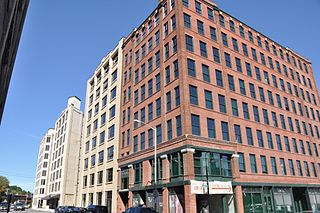
The L.H. Hamel Leather Company Historic District encompasses the largest tract of intact historical industrial buildings in downtown Haverhill, Massachusetts. The monumental factory complex of the L.H. Hamel Leather Company is located just west of Haverhill's central business district, and is roughly bordered on the west by the right-of-way for the former Boston & Maine Railroad, Essex Street on the south, Locke Street and Duncan Street on the east, and Winter Street on the north. The complex, which was built up between 1886 and 1929, was listed on the National Register of Historic Places in 2009.

The H. D. Smith Company Building is a historic industrial building at 24 West Street in Plantsville, Connecticut. With a construction history dating to 1882, it is one of the more architecturally interesting examples of Southington's industrial architecture, and was home to H. D. Smith & Co. from construction to the 1920s. It was listed on the National Register of Historic Places in 1977.

The Briggs Carriage Company is a historic industrial complex at 14 and 20 Cedar Street in Amesbury, Massachusetts. Built before 1890, these two buildings are a surviving reminder of the city's late 19th century prominence as a major carriage manufacturing center. They were listed on the National Register of Historic Places in 2007.

The Mansuy and Smith Automobile Showroom Building is a historic commercial building at 38-42 Elm Street in Hartford, Connecticut. Built about 1900, it is an early example of an automobile showroom, used by a local carriage manufacturer seeking to transition to the new technology. It was listed on the National Register of Historic Places in 2016.
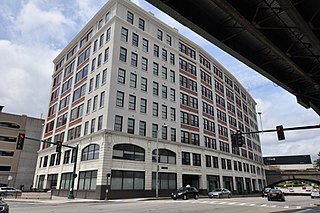
The Osgood Bradley Building is an historic industrial building at 18 Grafton Street in Worcester, Massachusetts. Completed in 1916, the eight-story brick building is notable for its association with the Osgood Bradley Car Company, an early manufacturer of both railroad cars and automobiles. The building was listed on the National Register of Historic Places in 2018.

The Commercial Exchange Building, also known as the Collins Manufacturing-Jackson Automobile Company Complex, is an industrial building located at 2301 E. Michigan Ave. in Jackson, Michigan. The building was built partly in 1895, and was listed on the National Register of Historic Places in 1993. The listing included four contributing buildings.








